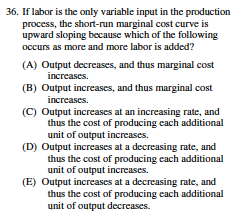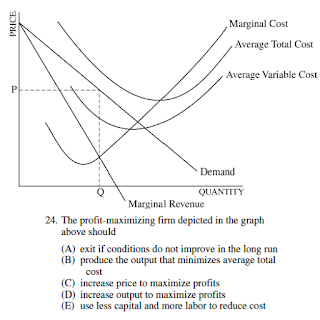2012 Multiple Choice (Output & Costs)
Answer - (B) rise initially, but eventually fall
Answer - (D) Average fixed costs
Understand that AFC = FC/Q
Example - FC = $100 and we produce 10 units then AFC = $100/10 = $10 meaning that each unit we produce covers $10 of the fixed costs.
If....
FC = $100 and we produce 1000 units then AFC = $100/1000 = $.1 or 10 cents. meaning that each unit produced covers $.1 or 10 cents of the fixed costs.
Answer -(E) Its marginal cost is $6, and its average variable cost is $5.50
Understand that this is a perfectly competitive firm in long-run equilibrium,
this means that P=MC & P = min ATC
Total revenue is $600 and TR = P x Q
Quantity = 100 so Price must be $6
So if P = $6 then MC must equal $6 as P=MC
If P = min ATC then ATC at this level of production = $6
AFC = FC/Q
So, AFC = $50/100 = $.50 or 50 cents each unit
If ATC = AFC + AVC
&
ATC $(6) = AFC$(.50)
and ATC - AFC = AVC
Then AVC = $6 - $.50 = $5.50
Answer - (D) $400
AVC = VC/Q
Q = 5
then ?/5 = an AVC of $100
VC = 500
500/5 = AVC $(100)
now,, with output of one more unit #6, AVC increases to $150
AVC = VC/Q
Q = 6
AVC = $150
so, ?/6 = $150
900/6 = AVC $(150)
&
900 = VC at output of 6 units
500 = VC at output of 5 units
MC = change in VC/ change in Q (output)
Change in VC = 400/ change in output = 1 unit
400/1 = 400
Answer - (D) Output increases at an decreasing rate,
and the cost of producing each additional unit of output increases
Understand that the College Board is trying to see if you recognise the effect of adding more labor (variable costs) to a fixed factor of production (factory)
Diminishing Returns/Productivity
As you add more inputs (labor, variable costs)
to a fixed factor of production (factory, machinery)
revenues/output increase at a increasing rate initially, but at some point revenues/output decrease decrease the rate of increase, and will eventually decrease.
Answer - (E) Economic profits are zero because price equals average total cost
AVC = $35
AFC = $30
ATC = $65 & P = $65 & MC = $65
Long-Run Equilibrium = P=MC=ATC
at LR Equilibrium a firm is making zero economic profit
Answer - (D) Average revenue is less than average variable cost
Understand and draw your graphs with your Demand curve labelled the AR curve.
IT is,,, and therefore will make sense once drawn.
Answer - (E) greater than zero
Understand that if total revenue is increasing as output increases we must be operating in the elastic section of the demand curve.
As the lower section of the demand curve (that is where MR is negative) is inelastic






















































